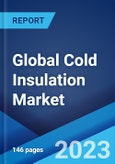The global cold insulation market size reached US$ 6.4 Billion in 2022. Looking forward, the market is expected to reach US$ 10.3 Billion by 2028, exhibiting a growth rate (CAGR) of 8.25% during 2022-2028.
Cold insulation is utilized wherein the operating temperature is below the room temperature. It assists in preventing condensation, moisture intrusion and long-term degradation. It comprises water, solvent and mastic-based vapor barrier, which is resistant to mechanical damages. Some of the commonly used materials in cold insulation include polyisocyanurate (PIR), polyurethane (PUR) rigid foam or cellular glass, and stainless steel or aluminized steel. At present, it is extensively utilized worldwide on account of its ability to protect the environment from greenhouse gas emissions.
Cold insulation is utilized wherein the operating temperature is below the room temperature. It assists in preventing condensation, moisture intrusion and long-term degradation. It comprises water, solvent and mastic-based vapor barrier, which is resistant to mechanical damages. Some of the commonly used materials in cold insulation include polyisocyanurate (PIR), polyurethane (PUR) rigid foam or cellular glass, and stainless steel or aluminized steel. At present, it is extensively utilized worldwide on account of its ability to protect the environment from greenhouse gas emissions.
Cold Insulation Market Trends
With the inflating disposable incomes of individuals, the demand for air conditioning and refrigerating devices is escalating around the world. This represents one of the key factors propelling the growth of the market. Apart from this, a considerable increase in awareness about the energy losses and costs are also contributing to the market growth. Moreover, cold insulation is increasingly being adopted across numerous industries like oil and gas. This, in confluence with rising concerns about the adverse impact of greenhouse emissions, is driving the market. Furthermore, leading market players are investing in research and development (R&D) activities to develop insulation materials through sustainable raw material sources. This, along with various initiatives undertaken by governing agencies of several countries to increase the energy efficiency of public infrastructure, is creating a favorable market outlook. Besides this, the rising adoption of cold insulation in food and chemical storage and cryogenic medical applications across the globe is acting as another growth-inducing factor. Other major factors, such as a surge in energy prices and the increasing usage of liquified petroleum gases (LPG), are anticipated to stimulate the market growth.Key Market Segmentation
This research provides an analysis of the key trends in each sub-segment of the global cold insulation market report, along with forecasts at the global, regional and country level from 2023-2028. The report has categorized the market based on insulation type, material type and application.Breakup by Insulation Type:
- Fibrous
- Cellular
- Granular
Breakup by Material Type:
- Fiber Glass
- Polyurethane Foam
- Polystyrene Foam
- Phenolic Foam
Breakup by Application:
- HVAC
- Chemicals
- Oil and Gas
- Refrigeration
Breakup by Region:
- North America
- United States
- Canada
- Asia-Pacific
- China
- Japan
- India
- South Korea
- Australia
- Indonesia
- Europe
- Germany
- France
- United Kingdom
- Italy
- Spain
- Russia
- Latin America
- Brazil
- Mexico
- Middle East and Africa
Competitive Landscape
The competitive landscape of the industry has also been examined along with the profiles of the key players being Armacell, Aspen Aerogels Inc., BASF SE, CertainTeed (Compagnie de Saint-Gobain S.A.), Covestro AG, Dow Inc., Evonik Industries AG, Huntsman Corporation, Kingspan Group plc and Owens Corning.Key Questions Answered in This Report:
- How has the global cold insulation market performed so far and how will it perform in the coming years?
- What has been the impact of COVID-19 on the global cold insulation market?
- What are the key regional markets?
- What is the breakup of the market based on the insulation type?
- What is the breakup of the market based on the material type?
- What is the breakup of the market based on the application?
- What are the various stages in the value chain of the industry?
- What are the key driving factors and challenges in the industry?
- What is the structure of the global cold insulation market and who are the key players?
- What is the degree of competition in the industry?
Table of Contents
1 Preface3 Executive Summary11 Value Chain Analysis13 Price Analysis
2 Scope and Methodology
4 Introduction
5 Global Cold Insulation Market
6 Market Breakup by Insulation Type
7 Market Breakup by Material Type
8 Market Breakup by Application
9 Market Breakup by Region
10 SWOT Analysis
12 Porters Five Forces Analysis
14 Competitive Landscape
Companies Mentioned
- Armacell
- Aspen Aerogels Inc.
- BASF SE
- CertainTeed (Compagnie de Saint-Gobain S.A.)
- Covestro AG
- Dow Inc.
- Evonik Industries AG
- Huntsman Corporation
- Kingspan Group plc
- Owens Corning
Methodology

LOADING...
Table Information
| Report Attribute | Details |
|---|---|
| No. of Pages | 146 |
| Published | November 2023 |
| Forecast Period | 2022 - 2028 |
| Estimated Market Value ( USD | $ 6.4 Billion |
| Forecasted Market Value ( USD | $ 10.3 Billion |
| Compound Annual Growth Rate | 8.3% |
| Regions Covered | Global |
| No. of Companies Mentioned | 10 |









